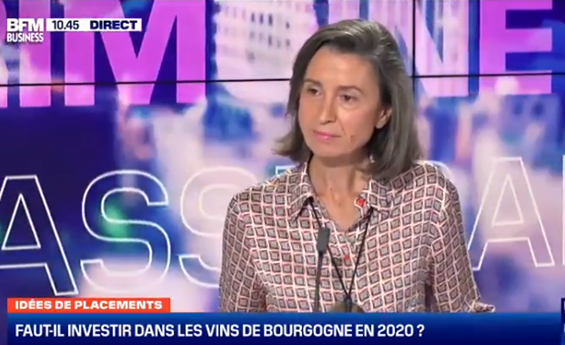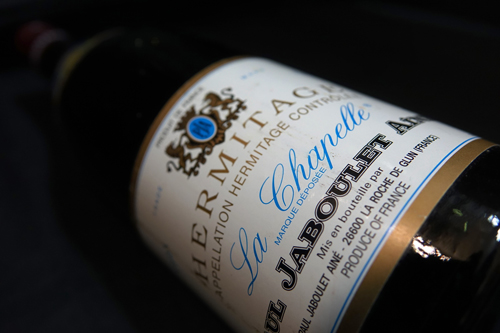
The Hospices de Beaune auction, planned for the 15th November, had to be postponed at the last minute. Angélique de Lencquesaing went on BFM Business to talk about Burgundy’s wine market.
The 160th Hospices de Beaune sale, traditionally held on the third Sunday of November, ended up not taking place on its planned date this year. Despite the lockdown, organisers had maintained that the event would happen in its traditional format, with a limited number of buyers present in the Beaune Hall. However, the Conseil des ventes – France’s regulatory body for auctions – took the decision to ban the sale due to continued restrictions linked to Covid. This situation has led to many changes in the auction world, with most auctions now having to migrate online. After much deliberation, the organisers eventually opted to postpone, rather than totally cancel, the auction, hoping to set a firm date once the sanitary situation looks better. As we will see, this sale is strategically important for Burgundy’s wine market.
A few days before the auction was still planned to happen, Angélique de Lencquesaing was on BFM Business where she responded to Cédric Decoeur’s questions.

The Hospices de Beaune auction is a chance for an update on Burgundy wine. From an investment point of view, these wines play quite an important role that’s worth analysing. So where do the wines sold at this auction come from?
The wines come from Domaine des Hospices de Beaune. They have around sixty hectares of vineyards across some of Burgundy’s finest appellations, not only the Côte de Beaune but also some grands crus from the Côte de Nuits and Chablis. Their particularity is that they’re made from the 2020 vintage and are sold just a few weeks after the harvest. They are still being matured in their casks, known as “pièces”, each containing 228L of wine.
How is the 2020 vintage looking?
I’m not sure many of us will want to be reminded of 2020…and yet the vintage is beautiful! The harvest was really early, and much better than the 2019 in Burgundy. Smaller quantities were harvested for the reds – which won’t be insignificant for prices – and this was a more generous year for white grapes.
A question in passing: is it a good idea to hold this event in person during a health crisis?
The decision to continue with the auction has been taken very seriously. It has been organised in rigorous conditions, with around 200 people allowed in the auction room compared to the usual 1,300. The sale can also be followed at a distance. I should also add that this auction is charitable, raising funds for the Beaune hospital, which needs it at the moment. This year there are 630 pièces going under the hammer compared to 600 last year (474 red wines and 156 white). Slightly larger volumes in a region that is often lacking a bit in its production.
Producers have found it hard to get their wine moving since the start of the year, though?
Yes, the health crisis and its effects on the economy, with lockdown, impact on supply chains, all of this has had dramatic consequences for the viticultural sector. Burgundy has been largely preserved due to the small quantities produced there, when considering the extent of global demand.
If we look at export figures since the start of the year, for example, Champagne has seen a drop of 31%, Bordeaux 28%, but Burgundy only 6%. However, whilst demand appears to be sustained for this region, stakeholders in the business are remaining careful. With this in mind, the fact that the Hospices de Beaune auction hasn’t been cancelled says a lot about the strategic importance of the event.
What do you mean by strategic importance?
The media attention this auction brings to Burgundy is essential for the image of its wine. Beyond questions of image, the auction has long been seen as a barometer for the region’s health. Every year, we’re asked if the barometer is broken, if the Hospices de Beaune sale is still a trustworthy reference point for market stakeholders. And I can confirm that, yes, this is still a keenly awaited sale! Merchants have no desire to see prices collapse, nor do they want bids to become excessive. Once the auction closes, the amounts reached become a benchmark for setting grape prices. So it’s quite a delicate balance that merchants are seeking, depending also on demand.
Do you recommend buying from the Hospices de Beaune sale from an investment point of view?
Burgundy is a highly-coveted region for collectors of fine wine, but not at just any price. So, the price levels reached this year need to be scrutinised. Since the vintage was good, the wine has promising ageing potential, a great asset for any investment cellar. We should note that Burgundy is now the best-represented region at auction in terms of value (36%), closely overtaking Bordeaux and the other main winegrowing regions. Auction results give a good indication of what proportions you should aim for fby region when building up a cellar.
More generally, have you seen prices stabilise at auction? Are wine enthusiasts less likely to bid at whatever cost?
Two things should be underlined: firstly, we’ve seen that fine, red wines from the Côte de Nuits have plateaued at stratospheric levels. More affordable regions like Côte Chalonnaise and Mâconnais, on the other hand, are doing well. It’s important not to neglect these wines, delicious and sought by a younger generation of wine drinkers…the big collectors of tomorrow!
Another notable trend is the progress made by white wine at auction. As we saw, the Hospices de Beaune auction is offering a higher number of white barrels this year, a phenomenon that can be observed across Burgundy. The region is getting whiter. In 2020, white grapes made up a surprising proportion of the harvest, 20% white, 80% red, something we’ve never seen before.
And is there demand for this?
Auction results reflect the state of the market very precisely, often quite a bit in advance. What we’re seeing at the moment is a high interest in Burgundy Chardonnay. One name stands out from the rest, Domaine Ramonet, which has some excellent grand cru parcels in the Côte de Beaune. Another trend to watch carefully is wine from the Meursault appellation, for which we’re seeing much increased demand. These wines have improved in quality since problems with premature oxidation were resolved, and they deserve a place in an investment cellar.
You mentioned exports, what about the US? Will the election of Joe Biden have consequences?
In the US, a market that traditionally represents a quarter of Burgundy wine exports, things are particularly complex due to the taxes brought in by the Trump administration. This means a 25% tax on French wine brought into the US, creating an unequal cost when compared with other importing countries. Louis-Fabrice Latour recently told me that Burgundy exports to the US have dropped by 28%, whilst sales are picking up in the UK and Asia. Expectations are high with Biden’s election. However, as we know, these taxes form part of a much bigger dispute to do with the aeronautical sector. The Minister for the Economy has recently pointed to keeping this issue in mind. But there is a risk that this will take some time to resolve. However, what counts is the market dynamism and demand for fine, Burgundy wine, and this remains intact!
See all the Burgundy wines for sale
Find out more about selling your bottles with iDealwine
Request a free estimate for your wine



